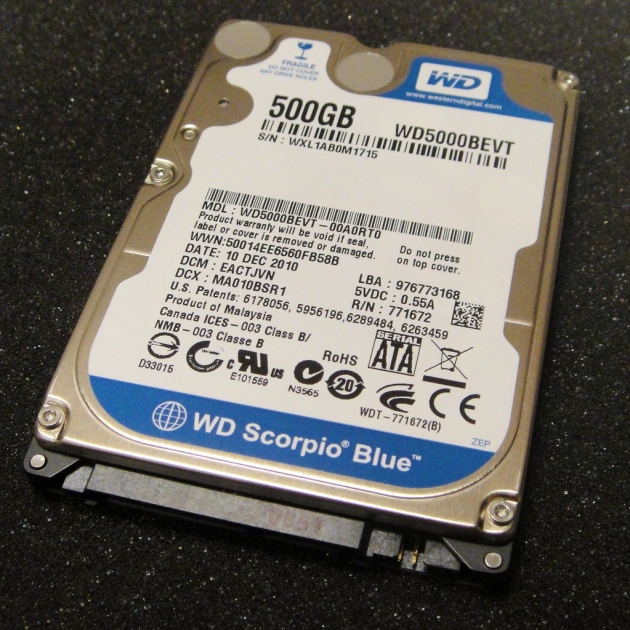Quest for silence: Quiet SATA notebook hard drives
April 19, 2014
When using a notebook computer for audio applications, unfortunately it isn’t simply a matter of buying the most reliable big hard drive. Using a notebook with either a Software Defined Radio (SDR) or as a playback device when recording from external components (such as a tuner) means noise matters. Hard drives produce noise which affects concentration in critical listening applications where the signal to noise ratios are critical… especially with ‘compromised audio’, which is often characteristic of weak radio signals or old recordings.
Hard drive evolution
The differences in hard drive technology are often quite obvious. Even within the last 15 years, the average person can readily compare old 3.5″ IDE hard drives to modern ones and notice the mammoth difference in audible noise, even with the software inactive (idle mode). More recently, there is often a noticeable difference between SATA drives with their increasingly rare IDE counterparts.
A decade ago, New York inventor Neil Singer suggested:
The level of noise in a disk drive is due to vibrations at particular frequencies, such as 6.6 KHz, 6.0 KHz, 5.0 KHz, 4.2 KHz, and 1.3 KHz. On the other hand, mechanical vibrations, which reduce seek time, result from vibrations at different frequencies, such as 3.3 KHz.
Today, Solid State Drives (SSDs) are generally considered to be ‘silent’ storage technologies. Problem solved, right? Perhaps, provided one has inordinate wealth! The cost associated with buying a huge SSD means these aren’t necessarily cost effective choices for radio DX applications where uncompressed audio demands may be onerous; a 6.14 MHz ‘spectrum chunk’ may consume as much as 120 GB of data per hour.
Research aids
For specific needs, the Silent PC Review (SPCR) test articles and forums are an invaluable, simple to understand resource in the quest for finding quiet hard drives, whether external, internal, desktop or laptop variants. Further, hard drive manufacturer Western Digital (whose part reliability is top notch) provides acoustic specifications in dBA on their website. Other manufacturers such as Hitachi & Seagate may also provide this data.
Much of this information (sadly, including this article!!!) becomes redundant quickly after publication. Before committing to recommended drives, it is prudent to check with manufacturers that there are not better performers that may have just been released.
Eventually the cost of SSD technology may become so affordable that it is foreseeable that there will be negligible demand for acoustic tests on the subject matter of this article. The reality is that SATA drives are older, less efficient performing drives but for now, remain perfectly appropriate choices. Drew Riley of Tom’s Hardware portal suggests:
Even though SSDs only account for 10% of the total market, growth over the next few years is expected to be explosive.
Needs analysis
This blogger wanted to buy a 2 TB hard drive for a new notebook which is already furnished with a single 1TB (5400 rpm) drive, which incorporates a second bay for a secondary hard drive. SSD drives were not considered due to cost; a typical 1 TB drive costs over $600 and over half that for 0.5 TB. Although fast, external USB 3.0 drives were also not considered due to already congested desk space. Hell, there’s enough crap lying around!
Whilst affordable, those desirable 2TB SATA drives are typically considerably noisier than their smaller capacity counterparts. So significant was the increase in noise (based on the dBA specifications) this prompted a reassessment as to whether bigger was necessarily critical for the particular SDR application. If the noise is problematic, even if there are two internal bays, it’s not so easy to switch internal drives off unlike an external drive. Therefore it’s probably worthwhile to research the most appropriate internal drive, rather than be forced to tolerate a noisy drive by judicious use of headphones or a proportionate increase in playback volume!
Three top candidates
Priced from $45 including domestic shipping:
Western Digital Scorpio Blue 0.5 TB with SATA 6 Gb/s interface (WD5000LPVX)
Manufacturer specifications (dBA): idle 17, average seek 22.
Priced from $62 including international shipping:
Western Digital Scorpio Blue 0.5 TB with SATA 3 Gb/s interface (WD5000LPVT)
Manufacturer specifications (dBA): idle 17, average seek 22.
This drive won the Editor’s Choice at SPCR.
Priced from $125 including domestic shipping:
Western Digital Blue 1 TB (WD10SPCX)
Manufacturer specifications (dBA): idle 20, average seek 21.
One of the quietest 0.5 GB drives, the WD5000MPCK (idle: 15, seek: 17) was unfortunately no longer readily available. Obviously, when reading the dBA specification, lower is quieter. To convert between acoustic units please use the calculator below. It seems that manufacturer Seagate for example, cites noise measurements using bel units rather than dBA.
Further reading
Benefits of Solid State Drives
Eight different 2TB hard drives, with dBA measurements
Things you can do to have older laptops quiet again





















